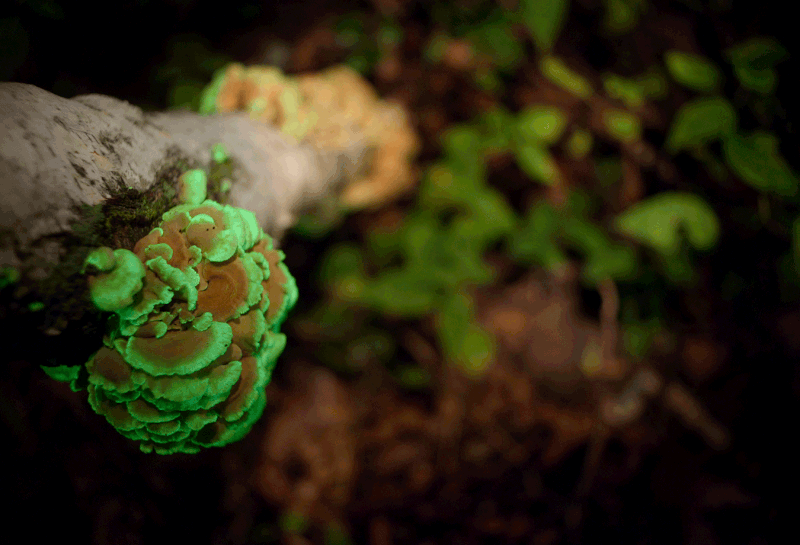The winners are in: the top new species of 2010, as selected by the International Institute for Species Exploration at Arizona State University in Phoenix. From glow-in-the-dark mushrooms and steel-eating bacteria to giant leeches and bizarre pancake fish, New Scientist takes a look at the ones that made the cut.

Spinning the world's largest webs
The webs of the Darwin's bark spider (Caerostris darwini) could catch a lot more than a solitary fly they have been found spanning rivers, streams and lakes. Up to 2.8 square metres in area, they are the largest known orb-style webs of any species. The silk that makes them up is remarkably strong: more than 10 times stronger than a similarly sized piece of Kevlar, it is reportedly the toughest biological material ever studied.
(Image: Matja Kuntner (Scientific Research Centre of the Slovenian Academy of Sciences and Arts)

Glow-in-the-dark mushroom
Collected on some of the last remaining Atlantic forest habitat near Sao Paulo, Brazil, the eternal light mushroom (Mycena luxaeterna) glows 24 hours a day. The tiny gel-coated mushrooms emit a bright yellow-green light, and bring the total number of known bioluminescent fungi to 71 out of an estimated 1.5 million species.
DNA sequencing of the species is helping researchers understand the origin and evolution of luminescence in fungi.
(Image: Cassius V. Stevani/Instituto de Química/Univ. de São Paulo, Brazil)

Steel-eating bacteria
An unexpected treasure to find on a shipwreck, these iron-oxide-eating bacteria were discovered on a rusticle collected from the sunken wreck of the Titanic. Named after the ship, Halomonas titanicae sticks to steel surfaces to form knob-like mounds of corrosion products that have, with the help of other micro-organisms, contributed to the deterioration of the ship's metal.
Eventually, the deterioration will lead to Titanic's disappearance. Researchers believe the bacterium could prove useful in disposing of other wrecked naval and merchant ships lying on the ocean floor.
(Image: RMS Titanic Inc.)

Hidden giant
At 2 metres in length, it seems astonishing that the golden spotted monitor lizard (Varanus bitatawa) has eluded biologists for so long. Found only in the Northern Sierra Madre Forest, Luzon Island, in the Philippines, the brightly coloured lizard spends most of its time in trees believed to be the reason why it hadn't been found by biologists before.
(Image: A. C. Diesmos/National Museum of the Philippines)

Pollinating cricket
Glomeremus orchidophilus, discovered on the island of Réunion, belongs to a subfamily of crickets that make a raspy sound. However, this particular species distinguishes itself from its cousins: it is the sole pollinator of the rare orchid Angraecum cadetii.
(Image: Sylvain Hugel/Université de Strasbourg, France)

Market find
This new species of duiker (Philantomba walteri) first turned up at a bushmeat market in west Africa. Its appearance is a reminder of the species that remain to be described, even within groups of animals that are regularly exploited for food or rituals.
(Image: Yann Le Bris)

King leech
At 5 centimetres long, it's easy to see how the Tyrannobdella rex (which translates as "tyrant leech king") got its name. The leech is the only known species with a single jaw and large teeth, and was discovered feeding on the nasal mucous membrane of a child in Peru.
There are currently 600 to 700 species of leeches described, but more surprises could be to come there could be as many as 10,000 more species throughout the world.
(IMage: PLoS ONE)

Underwater fruit
In the clear, cold waters of the upper Rogue river in Oregon lives an odd type of underwater life. The gilled mushroom (Psathyrella aquatica) was observed over 11 weeks and is the first report of a mushroom fruiting underwater.
(Image: Robert Coffan/Southern Oregon University, USA)

Jumping cockroach
Previously thought to have lived only in the Late Jurassic, the jumping cockroach made a reappearance in South Africa last year. The "leaproach" (Saltoblattella montistabularis) has an unusual anatomy: its legs are highly modified compared with other cockroaches, and its antennae have an additional fixation point to help improve the insect's stabilisation while jumping.
Thanks to all the modifications, the leaproach can jump about as well as a grasshopper.
(Image: Mike Picker/University of Cape Town, South Africa)

Pancake fish
This bizarre-looking species was discovered just before the Gulf of Mexico oil spill. The Louisiana pancake batfish (Halieutichthys intermedius) lives on the bottom of the ocean and uses its thick spiky fins to hop.
Its existence is precarious as its entire known habitat has been affected by the oil spill.
(Image: Prosanta Chakrabarty/Louisiana State University, USA)
Story Here







